You could add material to this page! The Wiki is easy to use; we can help walk you through it.
(Tweet is our local bird expert; Mugwort is helping put together this list, partly from the Cornell site. Other helpers and contributors would be great! Someday there might be a list of plants, too: trees, flowers, herbs, aliens, hazards)
Year-round. The most common hawk in North America.
Large, with very broad, rounded wings and a short, wide tail. Large females seen from a distance might fool you into thinking you’re seeing an eagle. (Until an actual eagle comes along.) Rich brown above and pale below, with a streaked belly and dark bar on the wing underside between shoulder and wrist. In young birds, tail is brown and banded.
“Dark-morph” are all chocolate-brown with a warm red tail; “rufous-morph” have reddish-brown chest and a dark belly.
Heavy wingbeats. Sometimes face into high winds, hovering without flapping, eyes fixed on the ground. Attack in a slow-controlled dive with legs out — very different from a falcon’s swoop. Habitat: open country all over the continent.
Rufous morph
Nest: pile of dry sticks, up to 6½’ high and 3′ wide, lined with bark strips, fresh foliage, and dry vegetation, in the crown of a tall tree with clear view. Food: Small animals (<1 ounce to >5 pounds), mostly mammals (mice, rabbits, ground squirrels) but also birds and snakes. Call: Whenever a hawk or eagle appears in film or video, the shrill cry is almost always really a Red-tailed Hawk.
Adults make a hoarse, screaming kee-eeeee-arr. It lasts 2-3 seconds and is usually given while soaring. During courtship, they also make a shrill chwirk, sometimes giving several of these calls in a row.
The Pileated Woodpecker is one of the biggest, most striking forest birds on the continent. It’s nearly the size of a crow, black with bold white stripes down the neck and a flaming-red crest. Look (and listen) for Pileated Woodpeckers whacking at dead trees and fallen logs in search of their main prey, carpenter ants, leaving unique rectangular holes in the wood.
Very large woodpecker with bright red crest, black back and underparts, black stripe through eye. In flight, the bird reveals extensive white underwings and small white crescents on the upper side, at the bases of the primaries. Male has red whisker stripe on face; female has dusky-gray forehead and mustache stripes.
Female
Habitat: old forest with large, standing dead trees and downed wood. Nest: cavity in a dead tree; entrance hole is oblong. Food: carpenter ants, supplemented by other ants, woodboring beetle larvae, termites, and other insects such as flies, spruce budworm, caterpillars, cockroaches, and grasshoppers. They also eat wild fruits and nuts. Call: Pileated Woodpeckers are quite vocal, typically making a high, clear series of piping calls that lasts several seconds; similar to a Northern Flicker’s rattling call. They also give shorter calls that sound like wuk, wuk or cuk, cuk to indicate a territory boundary or to give an alarm.
A small, active songbird, particularly common among live oaks. Greenish-gray above and below; whitish eyering, broken above eye; two whitish wingbars; short tail; small bill. Habitat: evergreen forests. Food: insects and spiders. Nest: open cup suspended by rim from a fork near ends of horizontal tree branches. Woven of lichens, spiderweb, plant down, bark shreds, fine grasses, small green leaves, and moss. Call: Series of scratchy two-note phrases, “zu-wee, zu-wee, zu-wee.”
Year-round.
Large, striking sparrow of sun-baked thickets of the West. When you catch sight of one, they’re gleaming black above (females are grayish), spotted and striped with brilliant white. Their warm rufous flanks match the dry leaves they spend their time hopping around in. The birds can be hard to see in the leaf litter, so your best chance for an unobstructed look at this handsome bird may be in the spring, when males climb into the shrub tops to sing their buzzy songs. Habitat: dry thickets, brushy tangles, forest edges, places with dense shrub cover and plenty of leaf litter to scratch around in. Food: Insects, acorns, berries, seeds. Nests in grass on the ground.
Spotted Towhees rummage in the leaf litter or creep through thick shrubs. Towhees tend to hop wherever they go, moving deliberately and giving themselves plenty of time to spot food items. They scratch at leaves with a characteristic two-footed backward hop, then pounce on anything they’ve uncovered. Song starts with one or two (up to eight) short introductory notes and then a fast trill that can sound like a taut rubber band being plucked, or a piece of paper stuck into a fan. Some Spotted Towhee songs have just the trill phrase only.
Dark-eyed (Oregon) Junco (Junco hyemalis)
Wild Turkey (Meleagris gallopavo)
Summer ’15: A group of three generations has been all over the Sanctuary, surprisingly bold.
Hefty songbirds with very large bills that are conical and thick at the base. Large heads and short, thick necks; a short tail.
Breeding males are rich orange-cinnamon with a black head and black-and-white wings. Females and immature males are brown above with warm orange or buff on the breast, and some have streaks on the sides of the breast. All have grayish bills. In flight, they flash bright yellow under the wings. Habitat: edges where different zones meet, with a diversity of plants and ready access to water. A combination of large trees and rich understory seems ideal.
Nest: loosely-constructed with good ventilation, about 5–7 inches across and 2–4 inches deep. Made of slim twigs, stems, rootlets, and pine needles with no mud or cementing. Placed in outer branches of a small tree or bush near a stream. Food: Insects (especially beetles), spiders, other animals, fruits and seeds. Commonly poison oak and weed seeds such as dock, pigweed, chickweed, and bur clover. Also cultivated orchard fruit like apricots, plums, and blackberries. Song whistled, rising and falling like a Robin’s, but longer, sweeter, more varied, and less choppy. Both males and females sing. Call a sharp spik uttered frequently to keep contact with mates while foraging. They utter an upslurring wheet upon taking flight.
5’14: Two seen in the meadow recently; have been scarce before.
Summer (breeding).
Small songbird. Short, thick bill. Two wingbars. Breeding male with blue head and back, red chest, and white belly. Female and nonbreeding male dull brown. Habitat: Bushy hillsides, riparian habitats, wooded valleys, sagebrush, chaparral, open scrub, recent post-fire habitats, thickets and hedges along agricultural fields, and residential gardens.
Nest: Open cup of coarse grasses, strips of bark, and leaves, wrapped in silk. Placed in shrub, close to ground. Food: Seeds, fruits, and insects. Comes to bird feeders. Song a high, strident series of warbled phrases. Call a dry chip.
Each male two years of age and older sings only one song, composed of a series of different syllables, and unique to that individual.
Year round.
1’15: Sawyer sights one sunning on an elderberry.
Yellow-Breasted Chat (Icteria virens)
Summer (breeding). 5’14: Getting revved up, waking folks in the morning.
Medium-sized songbird. Bright yellow chest and throat. Olive-green back. White spectacles. White belly and undertail. Long tail. Habitat: Dense second-growth, riparian thickets, and brush. Food: Insects. Foliage Gleaner. Nests in Shrub. Song a collection of whistles, cackles, mews, catcalls, caw notes, chuckles, rattles, squawks, gurgles, and pops. Call a sharp “chuck.”
Western Kingbird (Tyrannus verticalis) Flycatcher
Summer (breeding).
An eye-catching bird with ashy gray and lemon-yellow plumage, a familiar summertime sight in open habitats across western North America. This large flycatcher sallies out to capture flying insects from conspicuous perches on trees or utility lines, flashing a black tail with white edges. They are aggressive and will scold and chase intruders (including Red-tailed Hawks and American Kestrels) with a snapping bill and flared crimson feathers they normally keep hidden under their gray crowns. Habitat: Open areas – grassland, cultivated fields. Nest in trees, shrubs, on poles, buildings. Food: insects (bees and wasps, grasshoppers and crickets, beetles, moths and butterflies, caterpillars, flies, bugs, and spiders), during the day. Occasionally fruit. A kingbird on the hunt may capture two or more insects before returning to its perch, where it shakes them or beats them against the perch to subdue them. Call: Sharp kip notes and squeaky twitters. Male gives a harsh, buzzing call when attacking predators or other kingbirds. Starting just before sunrise, breeding males perch on tree limbs or wires and give a rising series of sharp kips, culminating in a frantic burst of loud descending notes
Western Wood-Pewee (Contopus sordidulus) Flycatcher
Summer (breeding).
A medium-sized, drab flycatcher. Grayish olive above. Pale below, with darker wash on breast and sides. Whitish wingbars. Habitat: Breeds in open woodlands, along forest edges, and in riparian woodlands. Winters in mature tropical forest.
Nest: A shallow cup of woven grass bound together with spider webs and covered on outside with moss, bud scales, or insect puparia. Lined with hair or fine grass. Placed in fork of horizontal branch of tree. Food: Flying insects, especially flies, ants, bees, wasps, beetles, moths, and bugs. Flies out from perch in middle part of understory to catch a flying insect and then returns to the same perch. Call a harsh, burry “pee-eer,” descending in pitch.
Willow Flycatcher (Empidonax traillii)
Olive-Sided Flycatcher (Contopus cooperi)
Anna’s Hummingbird (Calypte anna)
Year-round.
Mostly green and gray, without any rufous or orange marks on the body. The male’s head and throat are covered in iridescent reddish-pink feathers that can look dull brown or gray without direct sunlight. Habitat: Open woodland.
In the first half of the 20th century, the Anna’s Hummingbird bred only in northern Baja California and southern California. The planting of exotic flowering trees provided nectar and nesting sites, and allowed the hummingbird to greatly expand its breeding range.
Female
Nests in trees. Food: nectar. Song is long for a hummingbird (10 seconds or more); a series of buzzes, then a clearer, more tuneful whistle, followed by more emphatic chip notes. Calls are a series of short, sharp chip notes that may be given one at a time or one after another to make a twittering sound.
5’14: Moving up the ridge to the North.
Year-round.
A large quail with a long straight head plume. Brown above, with gray head, neck, and breast; chestnut throat; chestnut flanks with bold white bars. Female similar, but duller. Habitat: Dry mountains, brushy wooded areas, and chaparral.This quail migrates on foot from its high-elevation breeding territory to protected valleys, where it winters in coveys of 6 to 12 birds. Mountain Quail are difficult to flush since they persistently run through the thickest cover.
Nest 8-12 light reddish eggs in a depression lined with dry grass and leaves, hidden among protective rocks, logs, or thick vegetation.
Its frequent call is a loud echoing kyork or woook. Other notes include soft whistles.
They live here; two are left, out of the original two dozen many years back.
In the early days of the European colonisation of North America, the native wild turkey (Meleagris gallopavo) was confused with this species. This led to the English name of the American bird, since Turkey and Guinea were equally far-off and exotic places.
Helmeted Guineafowl are great runners, and can walk 10 km and more in a day.
Food: a variety of animal and plant food; seeds, fruits, greens, snails, spiders, worms and insects, frogs, lizards, small snakes and small mammals.
Guineafowl are particularly well-suited to consuming massive quantities of ticks.
Great Horned Owl
Tree Swallow
Stellar’s Jay
Wrentit
Golden-crowned Kinglet
Warbling Vireo
Solitary Vireo
Nashville Warbler
Birds Around the Sanctuary
Most Common Year-Round
Canada Goose
Red-tailed Hawk (Buteo jamaicensis)
Large, with very broad, rounded wings and a short, wide tail. Large females seen from a distance might fool you into thinking you’re seeing an eagle. (Until an actual eagle comes along.) Rich brown above and pale below, with a streaked belly and dark bar on the wing underside between shoulder and wrist. In young birds, tail is brown and banded.
“Dark-morph” are all chocolate-brown with a warm red tail; “rufous-morph” have reddish-brown chest and a dark belly.
Heavy wingbeats. Sometimes face into high winds, hovering without flapping, eyes fixed on the ground. Attack in a slow-controlled dive with legs out — very different from a falcon’s swoop.
Habitat: open country all over the continent.
Nest: pile of dry sticks, up to 6½’ high and 3′ wide, lined with bark strips, fresh foliage, and dry vegetation, in the crown of a tall tree with clear view.
Food: Small animals (<1 ounce to >5 pounds), mostly mammals (mice, rabbits, ground squirrels) but also birds and snakes.
Call: Whenever a hawk or eagle appears in film or video, the shrill cry is almost always really a Red-tailed Hawk.
Adults make a hoarse, screaming kee-eeeee-arr. It lasts 2-3 seconds and is usually given while soaring. During courtship, they also make a shrill chwirk, sometimes giving several of these calls in a row.
California Quail (Callipepla californica)
Western Screech Owl (Megascops kennicottii)
Pileated Woodpecker (Dryocopus pileatus)
The Pileated Woodpecker is one of the biggest, most striking forest birds on the continent. It’s nearly the size of a crow, black with bold white stripes down the neck and a flaming-red crest. Look (and listen) for Pileated Woodpeckers whacking at dead trees and fallen logs in search of their main prey, carpenter ants, leaving unique rectangular holes in the wood.
Very large woodpecker with bright red crest, black back and underparts, black stripe through eye. In flight, the bird reveals extensive white underwings and small white crescents on the upper side, at the bases of the primaries. Male has red whisker stripe on face; female has dusky-gray forehead and mustache stripes.
Habitat: old forest with large, standing dead trees and downed wood.
Nest: cavity in a dead tree; entrance hole is oblong.
Food: carpenter ants, supplemented by other ants, woodboring beetle larvae, termites, and other insects such as flies, spruce budworm, caterpillars, cockroaches, and grasshoppers. They also eat wild fruits and nuts.
Call: Pileated Woodpeckers are quite vocal, typically making a high, clear series of piping calls that lasts several seconds; similar to a Northern Flicker’s rattling call. They also give shorter calls that sound like wuk, wuk or cuk, cuk to indicate a territory boundary or to give an alarm.
Northern Flicker (Colaptes auratus)
Western Scrub Jay (Aphelocoma californica )
Black-capped Chickadee (Poecile atricapillus)
Winter Wren (Troglodytes hiemalis)
Robin
Hutton’s Vireo (Vireo huttoni)
A small, active songbird, particularly common among live oaks. Greenish-gray above and below; whitish eyering, broken above eye; two whitish wingbars; short tail; small bill.

Habitat: evergreen forests.
Food: insects and spiders.
Nest: open cup suspended by rim from a fork near ends of horizontal tree branches. Woven of lichens, spiderweb, plant down, bark shreds, fine grasses, small green leaves, and moss.
Call: Series of scratchy two-note phrases, “zu-wee, zu-wee, zu-wee.”
Spotted Towhee, Rufous-sided Towhee (Pipilo maculatus)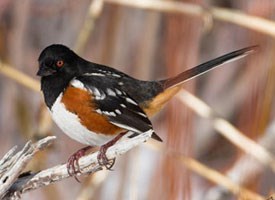
Large, striking sparrow of sun-baked thickets of the West. When you catch sight of one, they’re gleaming black above (females are grayish), spotted and striped with brilliant white. Their warm rufous flanks match the dry leaves they spend their time hopping around in. The birds can be hard to see in the leaf litter, so your best chance for an unobstructed look at this handsome bird may be in the spring, when males climb into the shrub tops to sing their buzzy songs.
Habitat: dry thickets, brushy tangles, forest edges, places with dense shrub cover and plenty of leaf litter to scratch around in.
Food: Insects, acorns, berries, seeds. Nests in grass on the ground.
Spotted Towhees rummage in the leaf litter or creep through thick shrubs. Towhees tend to hop wherever they go, moving deliberately and giving themselves plenty of time to spot food items. They scratch at leaves with a characteristic two-footed backward hop, then pounce on anything they’ve uncovered.
Song starts with one or two (up to eight) short introductory notes and then a fast trill that can sound like a taut rubber band being plucked, or a piece of paper stuck into a fan. Some Spotted Towhee songs have just the trill phrase only.
Dark-eyed (Oregon) Junco (Junco hyemalis)
Most Common Migratory
Rufous Hummingbird (Selasphorus rufus)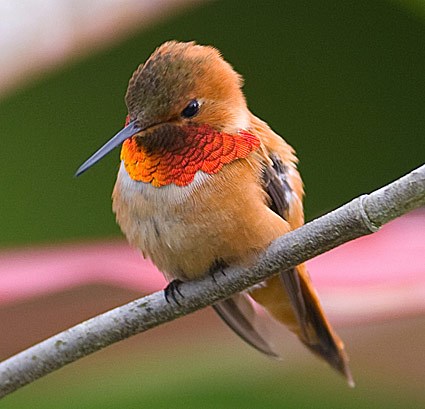
Violet-green Swallow (Tachycineta thalassina)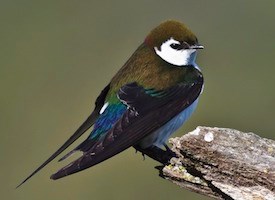
Ruby-crowned Kinglet (Regulus calendula)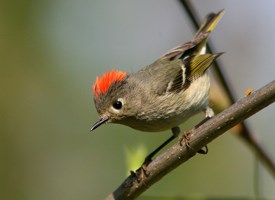
Hermit Warbler (Setophaga occidentalis)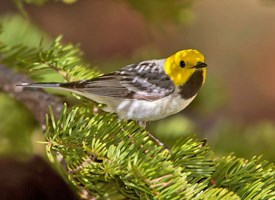
Western Tanager (Piranga ludoviciana)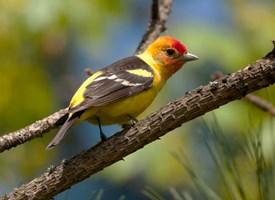
Black-headed Grosbeak (Pheucticus melanocephalus)
Hefty songbirds with very large bills that are conical and thick at the base. Large heads and short, thick necks; a short tail.
Breeding males are rich orange-cinnamon with a black head and black-and-white wings. Females and immature males are brown above with warm orange or buff on the breast, and some have streaks on the sides of the breast. All have grayish bills. In flight, they flash bright yellow under the wings.
Habitat: edges where different zones meet, with a diversity of plants and ready access to water. A combination of large trees and rich understory seems ideal.
Nest: loosely-constructed with good ventilation, about 5–7 inches across and 2–4 inches deep. Made of slim twigs, stems, rootlets, and pine needles with no mud or cementing. Placed in outer branches of a small tree or bush near a stream.
Food: Insects (especially beetles), spiders, other animals, fruits and seeds. Commonly poison oak and weed seeds such as dock, pigweed, chickweed, and bur clover. Also cultivated orchard fruit like apricots, plums, and blackberries.
Song whistled, rising and falling like a Robin’s, but longer, sweeter, more varied, and less choppy. Both males and females sing. Call a sharp spik uttered frequently to keep contact with mates while foraging. They utter an upslurring wheet upon taking flight.
Lazuli Bunting (Passerina amoena)
Summer (breeding).
Small songbird. Short, thick bill. Two wingbars. Breeding male with blue head and back, red chest, and white belly. Female and nonbreeding male dull brown.

Habitat: Bushy hillsides, riparian habitats, wooded valleys, sagebrush, chaparral, open scrub, recent post-fire habitats, thickets and hedges along agricultural fields, and residential gardens.
Nest: Open cup of coarse grasses, strips of bark, and leaves, wrapped in silk. Placed in shrub, close to ground.
Food: Seeds, fruits, and insects. Comes to bird feeders.
Song a high, strident series of warbled phrases. Call a dry chip.
Each male two years of age and older sings only one song, composed of a series of different syllables, and unique to that individual.
Others
1’15: Sawyer sights one sunning on an elderberry.
Yellow-Breasted Chat (Icteria virens)
5’14: Getting revved up, waking folks in the morning.
Medium-sized songbird. Bright yellow chest and throat. Olive-green back. White spectacles. White belly and undertail. Long tail.
Habitat: Dense second-growth, riparian thickets, and brush.
Food: Insects. Foliage Gleaner. Nests in Shrub.
Song a collection of whistles, cackles, mews, catcalls, caw notes, chuckles, rattles, squawks, gurgles, and pops. Call a sharp “chuck.”
Western Kingbird (Tyrannus verticalis) Flycatcher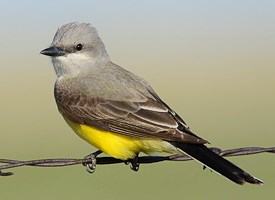
An eye-catching bird with ashy gray and lemon-yellow plumage, a familiar summertime sight in open habitats across western North America. This large flycatcher sallies out to capture flying insects from conspicuous perches on trees or utility lines, flashing a black tail with white edges. They are aggressive and will scold and chase intruders (including Red-tailed Hawks and American Kestrels) with a snapping bill and flared crimson feathers they normally keep hidden under their gray crowns.
Habitat: Open areas – grassland, cultivated fields. Nest in trees, shrubs, on poles, buildings.
Food: insects (bees and wasps, grasshoppers and crickets, beetles, moths and butterflies, caterpillars, flies, bugs, and spiders), during the day. Occasionally fruit. A kingbird on the hunt may capture two or more insects before returning to its perch, where it shakes them or beats them against the perch to subdue them.
Call: Sharp kip notes and squeaky twitters. Male gives a harsh, buzzing call when attacking predators or other kingbirds. Starting just before sunrise, breeding males perch on tree limbs or wires and give a rising series of sharp kips, culminating in a frantic burst of loud descending notes
Western Wood-Pewee (Contopus sordidulus) Flycatcher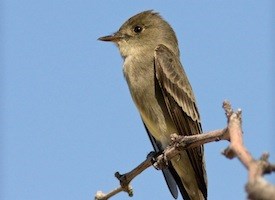
A medium-sized, drab flycatcher. Grayish olive above. Pale below, with darker wash on breast and sides. Whitish wingbars.
Habitat: Breeds in open woodlands, along forest edges, and in riparian woodlands. Winters in mature tropical forest.
Nest: A shallow cup of woven grass bound together with spider webs and covered on outside with moss, bud scales, or insect puparia. Lined with hair or fine grass. Placed in fork of horizontal branch of tree.
Food: Flying insects, especially flies, ants, bees, wasps, beetles, moths, and bugs. Flies out from perch in middle part of understory to catch a flying insect and then returns to the same perch.
Call a harsh, burry “pee-eer,” descending in pitch.
Willow Flycatcher (Empidonax traillii)
Olive-Sided Flycatcher (Contopus cooperi)
Anna’s Hummingbird (Calypte anna)
Mostly green and gray, without any rufous or orange marks on the body. The male’s head and throat are covered in iridescent reddish-pink feathers that can look dull brown or gray without direct sunlight.
Habitat: Open woodland.
In the first half of the 20th century, the Anna’s Hummingbird bred only in northern Baja California and southern California. The planting of exotic flowering trees provided nectar and nesting sites, and allowed the hummingbird to greatly expand its breeding range.
Nests in trees.
Food: nectar.
Song is long for a hummingbird (10 seconds or more); a series of buzzes, then a clearer, more tuneful whistle, followed by more emphatic chip notes. Calls are a series of short, sharp chip notes that may be given one at a time or one after another to make a twittering sound.
Mountain Quail (Oreortyx pictus)
Year-round.
A large quail with a long straight head plume. Brown above, with gray head, neck, and breast; chestnut throat; chestnut flanks with bold white bars. Female similar, but duller.
Habitat: Dry mountains, brushy wooded areas, and chaparral.This quail migrates on foot from its high-elevation breeding territory to protected valleys, where it winters in coveys of 6 to 12 birds. Mountain Quail are difficult to flush since they persistently run through the thickest cover.
Nest 8-12 light reddish eggs in a depression lined with dry grass and leaves, hidden among protective rocks, logs, or thick vegetation.
Its frequent call is a loud echoing kyork or woook. Other notes include soft whistles.
Helmeted Guineafowl (Numida meleagris)
Land Clowns!
In the early days of the European colonisation of North America, the native wild turkey (Meleagris gallopavo) was confused with this species. This led to the English name of the American bird, since Turkey and Guinea were equally far-off and exotic places.
Helmeted Guineafowl are great runners, and can walk 10 km and more in a day.
Food: a variety of animal and plant food; seeds, fruits, greens, snails, spiders, worms and insects, frogs, lizards, small snakes and small mammals.
Guineafowl are particularly well-suited to consuming massive quantities of ticks.
Great Horned Owl
Tree Swallow
Stellar’s Jay
Wrentit
Golden-crowned Kinglet
Warbling Vireo
Solitary Vireo
Nashville Warbler
Edited by mugwort on Jul 22, 2015 11:11 pm